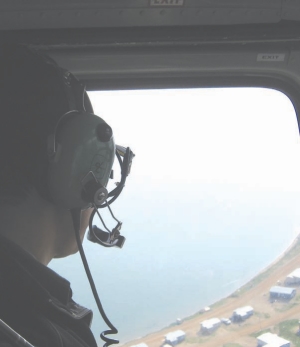Leon La Prairie says he has his old friend Hank Vuori to thank for discovering an anomaly in the Canadian Arctic that La Prairie firmly believes could be the next Sudbury basin or even Olympic Dam.
The chairman and director of Darnley Bay Resources (DBL-V) says Vuori spent 32 years in the Arctic with Inco, which included staking ground in the Rankin Inlet and Ferguson Lake areas. During a flight near Paulatuk in the Northwest Territories in 1954, the compass on his Husky aircraft started acting strangely.
“He had a charter for Inco and he noticed the compass going haywire,” La Prairie recounts.
The compass was just the first hint that something big was lying beneath the surface. In 1969 the Geological Survey of Canada (GSC), the country’s premier agency for geoscientific information and research, conducted a regional gravity survey as part of its national gravity coverage providing readings at 2.5 km to 20 km intervals over the area of Paulatuk and discovered a massive gravity anomaly.
In 1994 the GSC published a report giving the anomaly source a moderate-to-high rating for hosting Sudbury-style nickel-copper-platinum group element deposits, says La Prairie, whose 50 years in the mining business has included stints at Noranda Mines, Falconbridge Nickel and Inco.
The GSC suggested that the cause of the anomaly could be an igneous intrusive similar to that of the Sudbury basin (30 milligals); Norilsk in Russia (25 milligals) and the Bushveld complex (65 milligals).
The Darnley Bay anomaly is a 132-milligal gravity anomaly measuring 80 km by 100 km, with a roughly coincident 1,600 nanoteslas magnetic anomaly. Although buried, 3D modeling completed at the end of 2007 suggested a number of exploration targets on the upper surface at economic depths, the company says. Since December, Darnley Bay has spent $1.3 million on airborne gravity, versatile time-domain electromagnetic and magnetic surveys based on the results of new 3D modeling and has found at least 30 peaks and potential targets within 300-500 metres of surface.
“When you’re looking at something this big, that’s shallow,” explains La Prairie. “This is massive. . . you’re not looking for just one mine and you’re probably talking $10 billion to $15 billion dollars and probably seven to ten years before you have any production on it. You’re talking a whole new ball game.”
Paulatuk is about 885 km northwest of Yellowknife, near the Northwest Passage and close to the mouth of the Mackenzie River. La Prairie holds 5 million shares in the junior, which is currently trading at 36¢ apiece. The company has 103.3 million shares outstanding.
Darnley Bay expects to complete a 9,000-metre drill program in 2010 and early 2011 with the majority of the holes planned targeting depths in the range of 200 metres to 500 metres. Drilling commenced on Aug. 28.
Kerry Knoll, a director of Darnley Bay, jokes that he sold his stock in the company 10 years ago when the first hole hit sediment. But now he’s a true believer, pointing out that it wasn’t until Olympic Dam saw its tenth hole that they found anything.
“This anomaly has to be caused by something, it’s too strong to be just rock,” he says.
Knoll adds that there have been half a dozen research papers written on what the company says is North America’s strongest gravity anomaly, and is convinced there’s something to it.
“A lot of people think there are no Voisey’s Bays left but people are saying what could this be, they’re all intrigued, says Knoll, who cofounded Blue Pearl Mining (now Thompson Creek Metals [TCM-T, TC-N]), Glencairn Gold Corp., (now B2Gold Corp. [BTO-T]), and Wheaton River Minerals (now Goldcorp [G-T, GG-N]).
Stephen Reford, Darnley Bay’s president and chief executive, notes the company will be drilling about 50 km to the east of the first hole drilled in 2000. “Everything dips to the west,” he explains. “Ideally we’ll be finding things in the top 200 to 300 metres.”
La Prairie notes that Darnley Bay tried to get its hands on the property as early as 1991. It staked the land in 1994, but it wasn’t until 1997, after seven Senate hearings and negotiations with aboriginals in the area, that the company received rights to the property.
Today the Inuvialuit Regional Corp. is a significant shareholder in the company; it has the rights to back in on a 10% participation rate and will receive a 6% royalty on the sale of any metals produced from the project.


Be the first to comment on "Darnley Bay’s Arctic anomaly shows potential"